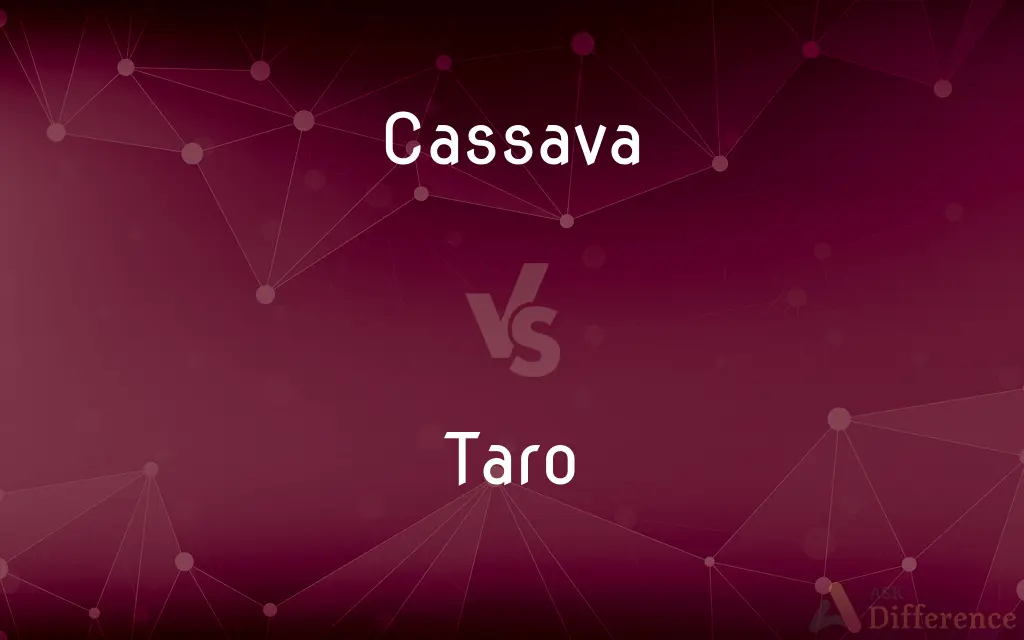Cassava vs. Taro — What's the Difference?
By Urooj Arif & Maham Liaqat — Updated on May 13, 2024
Cassava and taro are both starchy root vegetables, but cassava is larger and higher in calories, while taro is smaller with a nuttier flavor.

Difference Between Cassava and Taro
Table of Contents
ADVERTISEMENT
Key Differences
Cassava, primarily grown in tropical regions, is a major source of carbohydrates and known for its drought tolerance. Taro, on the other hand, is favored in Pacific Islands and parts of Asia, and requires a wet, humid environment to thrive. Both are foundational in their respective cuisines but have adapted to different agricultural conditions.
While cassava roots can grow quite large, up to several feet in length, taro roots (also known as corms) are generally smaller and more rounded. This size difference affects how they're harvested and processed in their respective regions.
Cassava must be properly processed to remove naturally occurring cyanide, making it safe for consumption. Taro, whereas, also needs careful handling to avoid skin irritation from oxalates, though its preparation is generally less hazardous than cassava.
Nutritionally, cassava is particularly high in calories and carbohydrates but low in protein. Taro, on the other hand, offers a slightly higher protein content, fiber, and a richer micronutrient profile, including potassium and vitamin C.
In culinary applications, cassava is often dried and ground into flour, known as tapioca, which is used in baking and pudding. Taro is frequently used to make poi in Hawaiian cuisine and is also popular in stews and as fried chips.
ADVERTISEMENT
Comparison Chart
Origin
Tropical Americas
Southeast Asia and Pacific Islands
Growth Environment
Drought-resistant
Requires wet, humid conditions
Size and Shape
Large, elongated
Smaller, rounded
Toxicity
Contains cyanide, needs careful processing
Contains oxalates, needs careful handling
Culinary Uses
Tapioca, puddings, baked goods
Poi, stews, chips
Compare with Definitions
Cassava
A tropical root vegetable used mainly for its carbohydrate-rich tubers.
Cassava is often converted into tapioca for use in gluten-free recipes.
Taro
A starchy root vegetable, known for its edible corm.
Taro is often mashed into poi, a traditional Hawaiian dish.
Cassava
Known for its drought resistance, making it a staple in arid regions.
Farmers in semi-arid regions prefer cassava because of its hardiness.
Taro
Requires a moist, humid environment for cultivation.
Taro fields are typically irrigated to simulate wetland conditions.
Cassava
Can be ground into flour or used to make tapioca.
Cassava flour is a popular alternative to wheat flour in baking.
Taro
Needs careful handling to avoid irritation from oxalates.
When preparing taro, it is important to wear gloves to prevent skin irritation.
Cassava
Requires processing to remove toxins before it can be eaten.
Proper preparation of cassava involves soaking and cooking to eliminate cyanide.
Taro
Edible starchy tuberous root of taro plants
Cassava
Manihot esculenta, commonly called cassava (), manioc, or yuca (among numerous regional names) is a woody shrub native to South America of the spurge family, Euphorbiaceae. Although a perennial plant, cassava is extensively cultivated as an annual crop in tropical and subtropical regions for its edible starchy tuberous root, a major source of carbohydrates.
Taro
Colocasia esculenta is a tropical plant grown primarily for its edible corms, a root vegetable most commonly known as taro (), kalo, dasheen, madhumbe, marope, magogoya, patra or godere (see §Names and etymology for an extensive list). It is the most widely cultivated species of several plants in the family Araceae that are used as vegetables for their corms, leaves, and petioles.
Cassava
The starchy tuberous root of a tropical tree, used as food in tropical countries.
Taro
A tropical Asian plant of the arum family which has edible starchy corms and edible fleshy leaves, especially a variety with a large central corm grown as a staple in the Pacific.
Cassava
The shrubby tree from which cassava is obtained, native to tropical America and cultivated throughout the tropics.
Taro
A widely cultivated tropical Asian aroid plant (Colocasia esculenta) having broad peltate leaves and large starchy edible corms.
Cassava
A shrubby tropical American plant (Manihot esculenta) widely grown for its large, tuberous, starchy roots.
Taro
The corm of this plant. In both senses also called cocoyam.
Cassava
The root of this plant, eaten as a staple food in the tropics only after leaching and drying to remove cyanide. Cassava starch is also the source of tapioca. In both senses also called manioc, yuca.
Taro
Colocasia esculenta, raised as a food primarily for its corm, which distantly resembles potato.
Cassava
Manioc (Manihot esculenta), a tropical plant which is the source of tapioca.
Taro
Any of several other species with similar corms and growth habit in Colocasia, Alocasia etc.
Cassava
Tapioca, a starchy pulp made with manioc roots.
Taro
Food from a taro plant.
Cassava
A shrubby euphorbiaceous plant of the genus Manihot, with fleshy rootstocks yielding an edible starch; - called also manioc.
Taro
A name for several aroid plants (Colocasia antiquorum, var. esculenta, Colocasia macrorhiza, etc.), and their rootstocks. They have large ovate-sagittate leaves and large fleshy tuberous rootstocks, which are cooked and used for food in tropical countries.
Cassava
A nutritious starch obtained from the rootstocks of the cassava plant, used as food and in making tapioca.
Taro
Herb of the Pacific islands grown throughout the tropics for its edible root and in temperate areas as an ornamental for its large glossy leaves
Cassava
A starch made by leaching and drying the root of the cassava plant; the source of tapioca; a staple food in the tropics
Taro
Tropical starchy tuberous root
Cassava
Cassava root eaten as a staple food after drying and leaching; source of tapioca
Taro
Has a nutty flavor and is higher in fiber and vitamins than many roots.
Taro adds a nutritious boost to any diet with its high fiber content.
Cassava
Any of several plants of the genus Manihot having fleshy roots yielding a nutritious starch
Taro
Often used in a variety of dishes from stews to desserts.
Taro chips are a tasty alternative to regular potato chips.
Cassava
High in calories and carbohydrates, with minimal protein.
Cassava provides quick energy due to its high carbohydrate content.
Common Curiosities
What is the main nutritional difference between cassava and taro?
Cassava is high in calories and carbohydrates, whereas taro provides more protein and micronutrients.
Is taro higher in fiber than cassava?
Yes, taro is generally higher in fiber compared to cassava.
How must cassava be processed before it is safe to eat?
Cassava must be soaked and cooked properly to remove toxic cyanide.
What are some popular dishes that include taro?
Popular taro dishes include poi, taro chips, and various stews.
What is cassava commonly used for?
Cassava is commonly used to make tapioca, flour, and various baked goods.
What are the environmental needs of taro for cultivation?
Taro needs wet, humid conditions to grow effectively.
What are the risks of handling taro?
Handling taro can cause skin irritation due to its oxalate content.
Are there any gluten-free uses for cassava?
Yes, cassava flour and tapioca are gluten-free and used in various recipes.
What makes taro a preferred choice in Pacific cuisine?
Its nutty flavor and versatility in dishes make taro popular in Pacific cuisine.
Why is cassava considered an important crop in developing countries?
Cassava is vital due to its high yield and carbohydrate content, supporting food security in developing regions.
Can cassava be eaten raw?
No, cassava cannot be eaten raw due to its cyanide content.
What type of climate is best for growing cassava?
Cassava thrives in tropical climates with minimal rainfall.
How does the taste of cassava compare to taro?
Cassava has a neutral taste, while taro has a slightly nuttier flavor.
How does cassava adapt to dry conditions?
Cassava's drought tolerance makes it a viable crop in arid and semi-arid regions.
What are the health benefits of including taro in your diet?
Taro is rich in fiber, potassium, and vitamin C, contributing to overall health.
Share Your Discovery

Previous Comparison
Snapdragon vs. Gladiolus
Next Comparison
Basic vs. BasisAuthor Spotlight
Written by
Urooj ArifUrooj is a skilled content writer at Ask Difference, known for her exceptional ability to simplify complex topics into engaging and informative content. With a passion for research and a flair for clear, concise writing, she consistently delivers articles that resonate with our diverse audience.
Co-written by
Maham Liaqat















































